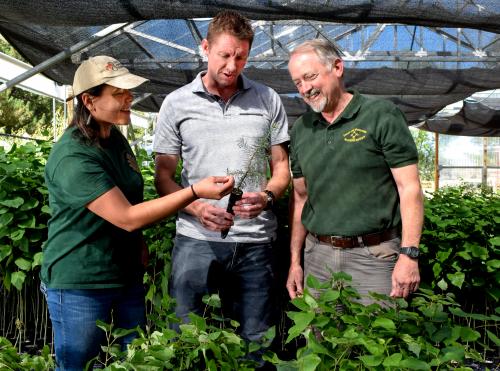NMSU to host forest restoration field day at Mora research center Sept. 14

“Our mission is to work together to restore proper ecological functions and ecosystem services in the forest landscape in New Mexico and the greater southwestern United States,” said Owen Burney, NMSU associate professor and superintendent of the Mora research center.
The group, known as FORT, will host a forest restoration field day from 9:30 a.m. to 3:30 p.m. Saturday, Sept. 14 at NMSU’s research and nursery facility in Mora.
“The purpose of the event is to provide information on the declining state of New Mexico’s forest and share current research and management strategies addressing some of these issues,” Burney said.
“We will also be emphasizing the need for a strong forestry education program in New Mexico. We want to open the dialogue for continued education and support on future directions,” he said.
There is no set presentation schedule for the field day, people may come and go as they please. The field day is free and open to the public.
“We will have a station with informational posters describing what’s happening in the state of New Mexico and what FORT is doing,” Burney said. “There will also be tours of various forest plantings, and people will be able to visit our greenhouse nursery.”
FORT is a triangular collaboration that brings together NMSU’s research and NMHU’s academics to prepare future foresters of the Southwest for the task of restoring the millions of forest acres that have been destroyed since 2000 when the frequency and intensity of forest wildland fires began increasing.
“We are the only university in New Mexico offering a bachelors’ of science degree in forestry with a concentration in either forest management or wildland fires,” said Blanca Cespedes, NMHU assistant professor of forestry of the program that has 70 students enrolled.
NMSU is providing the research leg of the triangle with the only program in the Southwest that focuses on forest nursery technologies, tree improvement and eco-physiology of young forest trees to facilitate ecological restoration and commercial reforestation.
“We have established a collaborative research lab at NMHU’s campus,” Burney said. “Highlands has wonderful wet chemistry lab facilities that we are using to run our research samples, with the help of Highlands’ students giving them an education in the lab.”
Highlands University students are able to work at NMSU’s research center nursery to conduct graduate research and to gain hands-on experience.
NMFWRI connects the two sides of the triangle with its statewide effort that engages government agencies, academic and research institutions, land managers and the interested public in the areas of forest and watershed management.
While NMSU is producing 300,000 forest seedlings annually for restoration, NMFWRI is focused on natural forest processes.
“We promote practices, which usually include thinning, that reduce catastrophic fires and improve ecosystem function, and then reintroducing frequent low intensity fires to help manage the forest,” said Kent Reid, director of the New Mexico Forest and Watershed Restoration Institute at Highlands, one of three such institutes in the nation.
The universities see promise in the trilateral collaboration that will benefit the future of forests in New Mexico, which cover a third of the state.


